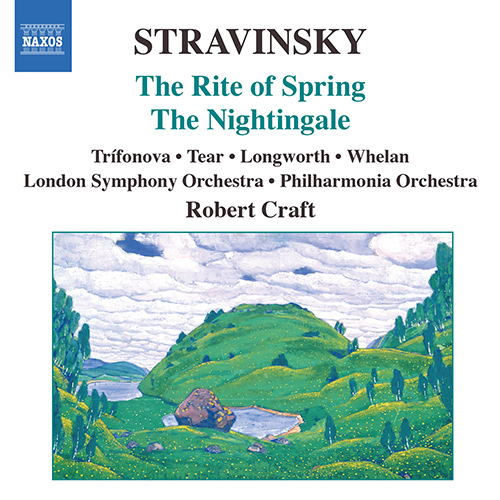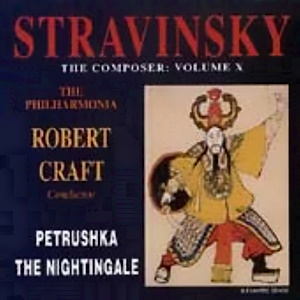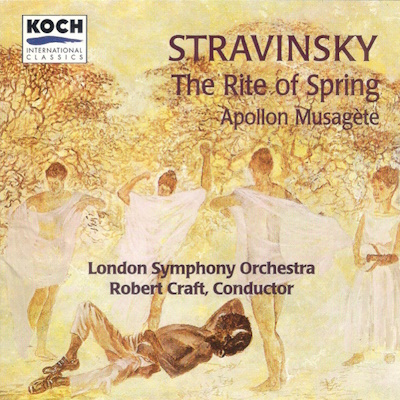 |
|
1 CD -
8.557501 - (c) 2005
|
|
IGOR
STRAVINSKY | ROBERT CRAFT - Volume 3
|
|
|
|
|
|
|
|
| Igor STRAVINSKY
(1882-1971) |
The
Rite of Spring (1911-13)
|
* |
|
31' 58" |
|
|
First Part -
Adoration of the Earth
|
|
|
|
|
|
-
Introduction
|
|
3' 19" |
|
1 |
|
-
The Augurs of Spring / Dances of the
Young Girls
|
|
3' 14" |
|
2 |
|
-
Ritual of Abduction
|
|
1' 19" |
|
3 |
|
- Spring
Rounds
|
|
3' 09" |
|
4 |
|
-
Ritual of the Rival Tribes
|
|
3' 10" |
|
5
|
|
-
Dance of the Earth
|
|
1' 18" |
|
6 |
|
Second Part - The
Sacrifice
|
|
|
|
|
|
-
Introduction
|
|
3' 31" |
|
7 |
|
-
Mystic Circles of the Young Girls
|
|
3' 08" |
|
8 |
|
-
Glorification of the Chosen One
|
|
1' 37" |
|
9 |
|
-
Evocation of the Ancestors
|
|
0' 41" |
|
10 |
|
-
Ritual action of the Ancestors
|
|
2' 58" |
|
11 |
|
-
Sacrificial Dance
|
|
4' 34" |
|
12 |
|
|
|
|
|
|
|
Solovei
- The
Nightingale
(1908-9;
1913-14) -
Lyric Tale in Three
Acts after Hans
Christian Andersen |
**
|
|
44' 30" |
|
|
Scene 1 - The
forest at dawn
|
|
|
|
|
|
-
Introduction |
|
3' 05" |
|
13 |
|
-
Fisherman
|
|
3' 32" |
|
14 |
|
-
Nightingale's Aria
|
|
3' 01" |
|
15 |
|
-
Chamberlain, Bonze, Cook, Courtiers
|
|
2' 50" |
|
16 |
|
-
Second Entrance of the Nightingale
|
|
0' 47" |
|
17 |
|
-
Chamberlain and Bonze
|
|
0' 24" |
|
18 |
|
-
Nightungale's Second Aria
|
|
0' 44" |
|
19 |
|
-
Chamberlain and Bonze
|
|
0' 52" |
|
20 |
|
-
Fisherman
|
|
1' 26" |
|
21 |
|
Scene 2 - The
porcelain palace of the Chinese
Emperor
|
|
|
|
|
|
-
Prelude: Chorus and Orchestra |
|
1' 27" |
|
22 |
|
-
Cook
|
|
0' 20" |
|
23 |
|
-
Reprise of the Prelude
|
|
0' 22" |
|
24 |
|
-
Chinese March
|
|
3' 10" |
|
25 |
|
-
Chamberlain
|
|
0' 14" |
|
26 |
|
-
Song of the Nightingale
|
|
4' 12" |
|
27 |
|
-
The Japanese Envoys
|
|
1' 18" |
|
28 |
|
-
The Mechanical Nightingale
|
|
0' 59" |
|
29 |
|
-
The Emperor, Chamberlain, Courtiers
|
|
0' 59" |
|
30 |
|
-
Reprise of the Chinese March
|
|
0' 50" |
|
31 |
|
-
Fisherman
|
|
0' 59" |
|
32 |
|
Scene 3 - The
Emperor's Bedchamber
|
|
|
|
|
|
-
Prelude
|
|
2' 43" |
|
33 |
|
-
Chorus of Ghosts, Emperor
|
|
1' 08" |
|
34 |
|
-
Nightingale |
|
2' 12" |
|
35 |
|
-
Death and the Nightingale
|
|
1' 29" |
|
36 |
|
-
The Nightingale's Aria
|
|
1' 25" |
|
37 |
|
-
Emperor and Nightingale
|
|
1' 41" |
|
38 |
|
-
Funeral Procession
|
|
1' 14" |
|
39 |
|
-
Fisherman |
|
1' 06" |
|
40 |
|
|
|
|
The rite of Spring
LONDON
SYMHPONY ORCHESTRA
Robert CRAFT
|
Solovei -
The Nightingale
Olga
Trífonova, Soprano
(The Nightingale)
Robert Tear, Tenor
(The Fisherman)
Pippa Longworth,
Soprano (The
Cook)
Paul Whelan, Bass-baritone
(The Emperor)
Stephen Richardson,
Bass (The
Chamberlain)
Andrew Greenan,
Baritone (The
Bonze)
Sally Burgess,
Alto (Death)
Peter Hall, Tenor
(Japanese Envoys 1 and
3)
Simon Preece, Bass
(Japanese Envoy 2)
London Voices
(Courtiers) by Terry
Edwards
PHILHARMONIA
ORCHESTRA
Robert CRAFT
|
|
|
|
|
|
Recorded
at: |
|
Abbey
Road Studio One, London (England):
- 1 to 4 July 1995 (The Rite of
Spring)
- 14 to 17 August 1997 (The
Nightingale)
|
|
|
Live / Studio
|
|
Studio |
|
|
Producer |
|
Michael
Fine (The Rite of Spring)
Gregory K. Squires (The
Nightingale)
|
|
|
Engineer |
|
Simon
Rhodes (The Rite of Spring)
Michael Sheady (The Nightingale)
|
|
|
Naxos Editions
|
|
Naxos
| 8.557501 | 1 CD | LC 05537 |
durata 76' 28" | (c)
2005 | DDD
|
|
|
KOCH
(previously released) |
|
Koch
International, Vol. II |
3-7359-2 | 1 CD | (p)
1996 | DDD (The Rite of
Spring)
|
|
|
MusicMasters
(previously released) |
|
MusicMasters,
Vol. X | 01612-67184-2 |
1 CD | (p) 1998 | DDD
(The Nightingale)
|
|
|
Cover |
|
Sketch for
the Rite of Spring by
Nicolas Roerich (1874-1947)
(Art Gallery of Astrakhan,
Russia / The Bridgeman Art
Library) |
|
|
Note |
|
-
|
|
|
|
|
|
MusicMASTERS
CLASSICS
Release (1991-1998)

1 CD - 01612-67184-2 - Volume
X
(c) 1998 **
|
KOCH
INTERNATIONAL
Release (1996-2002)
 1 CD -
3-7359-2 - Volume II
1 CD -
3-7359-2 - Volume II
(c) 1996 *
|
‘May
whoever listens to this music
never experience the insult to
which it was subjected and of
which I was the witness in the
Théâtre des Champs-Elysées,
Paris, Spring 1913’, wrote
Stravinsky in 1968, of the
première of his Rite of
Spring. Written for a huge
orchestra to a setting of scenes
from pagan Russia, this
elemental ballet with its
vaulting, violent energy and
assymetrical rhythms almost from
beginning to end, has become a
major landmark of 20th century
music. Stravinsky’s orchestral
palette, different and
distinctive in every work, is
never more exotically colourful
than in his one act opera The
Nightingale, which is a
virtual catalogue of avian
imitations.
The Rite of Spring
“Composing The
Rite, I had only my ear
to help me. I heard and I
wrote what I heard.”- Igor
Stravinsky
Stravinsky
was inspired by a vision of The
Rite of Spring while
completing The Firebird.
His own title for it was Vesna
Svyashchénnaya, Holy
Spring, and he was never
happy with Léon Bakst’s more
memorable Le Sacre du
printemps, believing that
“The Coronation of Spring” was
closer to his original meaning.
Soon after the success of The
Firebird, Stravinsky
contacted Nicolas Roerich,
artist, archaeologist,
ethnologist, whom he met through
his nephew, a fellowpupil of
Rimsky-Korsakov, to share his
vision and to propose
collaboration in a “choreodrama.
“Who else could help me,” he
wrote to the St Petersburg
critic N. F. Findeyzen, “who
else knows the secret of our
ancestors’ close feeling for the
earth?” During the summer of
1910, however, Stravinsky’s
imagination was seized by Petrushka,
and when Dyagilev and Nijinsky
visited him in Lausanne to
discuss Vesna Svyashchénnaya,
they were astonished to hear
sketches for a puppet drama,
which so fascinated Nijinsky
that he persuaded Dyagilev to
postpone The Rite.
Stravinsky explained the
predicament to Roerich, but
urged him to continue with the
scenario, and also to design its
costumes and sets. The following
summer, after the triumph of Petrushka,
Stravinsky returned to The
Rite. Wanting him to see
the Princess Tenisheva’s
collection of Russian ethnic
art, Roerich asked Stravinsky to
meet him at Talashkino, her
country estate near Smolensk, to
plan the structure of the
ballet. En route to the creation
of this prehistoric work,
Stravinsky found himself sharing
the cattle car of a freight
train with a glowering,
slavering bull—a tauromachian
encounter that surely must have
heightened the young composer’s
atavistic imagination. The work
with Roerich, the plan of action
and the titles of the dances,
was quickly completed.
The Rite was conceived as
two equal and complementary
parts, The Adoration of the
Earth, which takes place
in daytime, and The
Sacrifice of the Chosen One,
which takes place at night. The
Introduction to Part One
represents the reawakening of
Nature. The curtain rises at the
end of it for the Augurs of
Spring, in which an old
woman soothsayer is accompanied
by a group of young girls. The
Ritual of Abduction
follows, then the Round-dances
of Spring, the Ritual
of the Two Rival Tribes,
the Procession of the Sage,
the Sage’s Kiss of the Earth,
and the Dance of the Earth.
Part Two, “The Sacrifice,”
or as the composer called it, “The
Great Offering,” begins
after an Introduction to “the
secret night-games of the
maidens on the sacred hill”. The
music accompanying these
mysterious rituals is quiet but
foreboding. After two
intimations of danger,
effectuated first by harsh
chords in muted horns, then by
muted horns and trumpets, and by
eleven savage drum beats, a wild
dance, the Glorification of
the Chosen One, erupts,
leading without pause to the Evocation
of the Ancestors, the Ritual
Dance of the Ancestors,
and the Sacrificial Dance.
The Sacrificial Dance
began with an unpitched notation
of the rhythmic germ written
during a walk with Ravel in
Monte Carlo in the spring of
1912. Pierre Monteux, who would
conduct the riotous première of
The Rite in Paris, 29th
May, 1913, was also in Monte
Carlo, and was present when
Stravinsky played the notyet-
completed score for Dyagilev on
the piano. Monteux wrote to his
wife: “Before Stravinsky got
very far I was convinced he was
raving mad.… The walls trembled
as he pounded away, occasionally
stamping his foot and jumping up
and down.”
In a state of exaltation,
exhaustion, and “with a terrible
toothache”, Stravinsky finished
the composition on 17th
November, 1912. Most of the
instrumentation in score form
was completed by the end of
March 1913. The vaulting energy
of the penmanship close to the
end reflects the force of his
drive to complete his work. The
note-stems, flags, and beams of
the wind instruments, followed
later by those of the strings,
incline steeply toward the
right. The bolder, larger notes
were evidently written at high
speed; simply to see them is to
be swept along with the feeling
that a powerful creation is
coming to its end. After the
last bar, Stravinsky signed and
dated the score 4th April, 1913.
His comment in the
upper-right-hand corner of the
final page translates as
follows:
May whoever
listens to this music never
experience the insult to which
it was subjected and of which
I was the witness in the
Théâtre des Champs-Elysées,
Paris, Spring 1913.- Igor
Stravinsky. Zurich, 11th
October, 1968.
The
Nightingale
Stravinsky had just completed
the first scene of The
Nightingale, a one-act
opera in three scenes, when
Dyagilev invited him to compose
The Firebird. He put the
opera aside for this ballet and
its successors, Petrushka
and The Rite of Spring,
then returned to the vocal work
between July 1913 and 28th
March, 1914. The première took
place in Paris on 26th May,
1914, conducted by Pierre
Monteux.
Stravinsky chose Hans Christian
Andersen’s tale partly because
music itself is the story’s
underlying subject, the power of
music not only to delight and to
move, but also to conquer death,
for The Nightingale is a
version of the Orpheus legend.
Stravinsky loved Andersen’s
stories - Le Baiser de la
fée is based on another -
and he managed to incorporate
some of Andersen’s fantastic
touches into the libretto. He
invited Stepan Stepanovich
Mitusov, a friend from the
Rimsky- Korsakov circle, to
compose the libretto with him.
Mitusov in turn consulted
Vladimir I. Belsky, the
librettist for three
Rimsky-Korsakov operas. On 9th
March, 1908, in Belsky’s St
Petersburg apartment, the
threesome fashioned the
scenario. The original draft of
scene one survives in
Stravinsky’s hand, and is
remarkably close to the final
version.
Scene One: The forest at
dawn. A fisherman is
mending his net and lamenting
his fate, in which his sole
consolation is the singing of
the Nightingale. The Nightingale
arrives and comforts the
Fisherman with its song. The
bird flies away at the approach
of a group of courtiers that
includes the Emperor of China’s
chief retainer (Chamberlain),
Bonze (Chaplain), and Cook, who
tells the Chamberlain that the
Nightingale sings at dawn in
these very trees, and that they
will now hear it. But just then
the Fisherman’s cow begins to
moo (upward glissandos in cellos
and basses) and everyone is
transported. The Fisherman
respectfully reveals that it was
his cow. The Cook confirms this,
but promises that the
Nightingale will start to sing
right away. In the meantime some
frogs croak (oboes). The
Chamberlain lets it be known
that the Emperor wants to see
the Nightingale at court, hear
it sing, and, in the event of
success, reward it with the
order of the golden slipper. The
Nightingale agrees and flies
down onto the Kitchen Maid’s
arm. - Exeunt omnes.
Scene Two: The porcelain
palace of the Chinese Emperor.
The Chamberlain appears and
chases everyone away, for the
Emperor is coming with his
entourage. The procession of the
Chinese Emperor (Chinese March).
The Nightingale is brought out,
the Emperor commands him to
sing, and when he does, the
Emperor’s eyes fill with tears.
Suddenly the Japanese
ambassadors arrive bearing a
gift from their Emperor, an
artificial nightingale. This is
wound up to sing. The offended
real nightingale flies away, and
the offended Emperor angrily
denounces it and bestows the
title “Court Singer on the
Left-hand Night Table of His
Highness” upon the artificial
nightingale. The Emperor orders
the mechanical nightingale to be
wound up again. It starts to
sing, but the music stops
abruptly, the cylinders turn,
hum, squeak, and the machine
falls silent. After a great
commotion, the disappointed
Emperor orders his followers to
their bedchambers. Everyone
retires.
Scene Three: The Emperor’s
Bedchamber. In the
foreground is an anteroom, from
which courtiers appear to ask
the Chamberlain whether the
Emperor has died. He lies on the
bed in spiritual torment. Death
sits upon him, watching him, and
the evil deeds he has committed
hover around him. He wants to be
comforted, calls for help, and
asks his artificial bird to sing
for him, although “there is no
winder to wind you up”.
Unobserved, the real nightingale
flies in from the garden,
perches on a windowsill, and
begins to sing. After one song
Death curls himself into a
shroud, moves away and
disappears, flying out the
window. As the Nightingale sings
on, the ghosts of the Emperor’s
evil deeds also vanish, and he
falls asleep. The Nightingale
finishes, and the Emperor
awakes. He sees the little bird
in the window and begs it to
stay in the palace forever. The
bird cannot accept the offer but
it promises to fly to the
Emperor to inform him of the
sufferings of the poor and of
all that goes on in his Great
Kingdom. The little bird flies
away. The courtiers, thinking
the Emperor already dead,
approach on tiptoe; but the
Emperor meets them, dressed in
royal robes and carrying his orb
and sceptre, which he clutches
to his heart. In the dawn light,
he says “good day” to the
dumbfounded courtiers.
Stravinsky’s orchestral palette,
different and distinctive in
every work, is never more
exotically colourful than in The
Nightingale, which is a
virtual catalogue of avian
imitations: tremolos, trills,
appoggiaturas, gruppetti,
string harmonics, pizzicato
glissandos, flautando and
ponticello effects, harp and
piano arpeggios, harp harmonics,
and the retuning of cello
strings to produce harmonics on
unusual pitches. The voice of
Death is introduced by four icy
high notes in the celesta, and
Death’s aria is accompanied by
the strangulated sound of a
cello playing a double
appoggiatura on the bridge of
the instrument in a high
register. After vanquishing
Death in their vocal duel for
the Emperor’s life, the
Nightingale sweetly sings to him
accompanied by mandolin and
guitar. In the “Chinese March,”
the mandolin doubling the soft
melody of the trumpet is a
previously unheard instrumental
colour, and the percussion
effects explore a greater range
than in any other Stravinsky
work except Les Noces.
Stravinsky also increases the
range of cymbales antiques
of The Rite of Spring from
two to six pitches, five of them
tuned to the “black-key”
pentatonic scale. The high
trumpet in D, another hold-over
from The Rite,
alternates with a second
instrument in E flat. The oboe’s
rapid two-note descending scale
figure (1), representing the
mechanical movement of the
Japanese nightingale, is yet
another brilliant instrumental
invention; no wonder Stravinsky
wrote next to his sketch for the
passage: “I am very pleased with
this”.
Robert
Craft
(1)
Played on this recording by
David Theodore.
|
|
|
|
|

